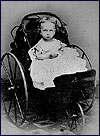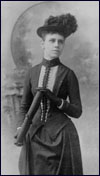|
|
|
| ||
|
| ||||
 Densmore in buggy - MHS
 Francis Densmore - MHS |
| FRANCES THERESA DENSMORE was born on May 21, 1867 in a converted schoolhouse on the banks of the Mississippi River. Her father, Benjamin Densmore, was a civil engineer and the owner of a foundry in downtown Red Wing, a small town about 60 miles down-river from St. Paul. The Densmores arrived in Red Wing from New York state by way of southeastern Wisconsin. Frances' grandfather, Orrin Densmore, was a prominent local judge, politician and sawmill owner. Benjamin and his brother Daniel volunteered to fight with the Union army during the Civil War. They arranged to bring what may have been the first African Americans to their small Minnesota town. The Densmores were a stable, modest, accomplished family. Frances grew up in a musical household she described as "Spartan in its severity." She remembered being lightly punished for playing "frivolous" music when she was supposed to be practicing. Her mother Sarah Adalaide (Greenland) Densmore may have been a taskmaster, but she also encouraged a certain open-mindedness.
My childhood home was near the shore of the Mississippi River and the Sioux Indians were camped on an island opposite the town. As a young woman, Densmore got the finest musical training of her day. She studied piano, organ and harmony at the Oberlin College Conservatory in Ohio. She later studied under eminent teachers in New York and Boston. At Oberlin, a school with a long history of integration, Densmore probably made her first personal contact with people of another race.
Dear ones at home: In her early twenties, Densmore taught music and played the church organ. She lived with her parents in Red Wing, settling into a life of modest middle-class comforts and genteel pastimes of an educated, unmarried woman. Then Densmore read about another brand of "quaint figures." She discovered the work of a remarkable contemporary anthropologist named Alice Cunningham Fletcher. Fletcher's 1893 book, A Study of Omaha Music, rekindled Densmore's interest in Native American music. The two women were vastly different in temperament, but they grew to share a common obsession: preserving Native culture before it evaporated.3 | ||
